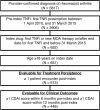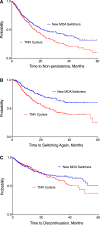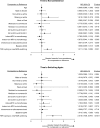Treatment Persistence and Clinical Outcomes of Tumor Necrosis Factor Inhibitor Cycling or Switching to a New Mechanism of Action Therapy: Real-world Observational Study of Rheumatoid Arthritis Patients in the United States with Prior Tumor Necrosis Factor Inhibitor Therapy
- PMID: 28674959
- PMCID: PMC5565674
- DOI: 10.1007/s12325-017-0578-8
Treatment Persistence and Clinical Outcomes of Tumor Necrosis Factor Inhibitor Cycling or Switching to a New Mechanism of Action Therapy: Real-world Observational Study of Rheumatoid Arthritis Patients in the United States with Prior Tumor Necrosis Factor Inhibitor Therapy
Abstract
Introduction: To examine treatment persistence and clinical outcomes associated with switching from a tumor necrosis factor inhibitor (TNFi) to a medication with a new mechanism of action (MOA) (abatacept, anakinra, rituximab, tocilizumab, or tofacitinib) versus cycling to another TNFi (adalimumab, certolizumab pegol, etanercept, golimumab, or infliximab) among patients with rheumatoid arthritis.
Methods: This retrospective, longitudinal study included patients with rheumatoid arthritis in the JointMan® US clinical database who received a TNFi in April 2010 or later and either cycled to a TNFi or switched to a new MOA therapy by March 2015. Cox proportional hazards models were used for time to non-persistence (switching or discontinuing). An ordinary least squares regression model compared 1-year reduction from baseline for the Clinical Disease Activity Index (CDAI).
Results: There were 332 (54.2%) TNFi cyclers and 281 (45.8%) new MOA switchers. During a median follow-up of 29.9 months, treatment persistence was 36.7% overall. Compared with new MOA switchers, TNFi cyclers were 51% more likely to be non-persistent (adjusted hazard ratio, 1.511; 95% CI 1.196, 1.908), driven by a higher likelihood of switching again (adjusted hazard ratio, 2.016; 95% CI 1.428, 2.847). Clinical outcomes were evaluable for 239 (53.3%) TNFi cyclers and 209 (46.7%) new MOA switchers. One-year mean reduction in CDAI from baseline to end of follow-up was significantly higher for new MOA switchers than TNFi cyclers (-7.54 vs. -4.81; P = 0.037), but the difference was not statistically significant after adjustment for baseline CDAI (-6.39 vs. -5.83; P = 0.607).
Conclusion: In this study, TNFi cycling was common in clinical practice, but switching to a new MOA DMARD was associated with significantly better treatment persistence and a trend toward greater CDAI reduction that was not significant after adjustment for baseline disease activity.
Funding: Sanofi and Regeneron Pharmaceuticals.
Keywords: Biologic disease-modifying anti-rheumatic drugs; Persistence; Rheumatoid arthritis; Rheumatology; TNFi; Treatment outcome; Treatment selection; Tumor necrosis factor inhibitor; bDMARDs.
Figures







References
-
- Singh JA, Furst DE, Bharat A, et al. 2012 update of the 2008 American College of Rheumatology recommendations for the use of disease-modifying antirheumatic drugs and biologic agents in the treatment of rheumatoid arthritis. Arthritis Care Res (Hoboken) 2012;64:625–639. doi: 10.1002/acr.21641. - DOI - PMC - PubMed
Publication types
MeSH terms
Substances
LinkOut - more resources
Full Text Sources
Other Literature Sources
Medical
Miscellaneous

